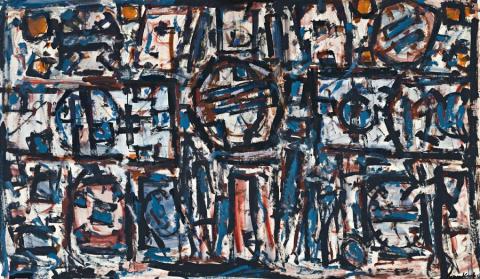SEQUENCE NO 6, 1965-75
Roger Kemp
synthetic polymer paint on paper on canvas
153.0 x 250.0 cm
signed lower right: Roger Kemp
Estate of the artist, Melbourne
Private collection, Melbourne
Roger Kemp Cycles and Directions 1935–1975, National Gallery of Victoria, Melbourne; Monash and Melbourne University Galleries, and Realities Gallery, Melbourne, 5 – 30 September 1978, cat. 78 (illus. exhibition catalogue)
Roger Kemp's Sequence No 6 is a classic of its kind, masterly in its orchestration of powerful geometric forms and rich in characteristic colours. Its feeling of vigorous movement is ordered by a succession of shapes and lines, one following the other, as the title implies, both into and across the picture plane. This is given further momentum by the red-based pigments, which provide a special warmth to the cool, white field, across which marks of black and strokes of blues play in ceaseless motion. As in the best of Kemp's work, it touches on infinity through its creative and repetitive energy, the paradoxes of movement and stillness inviting contemplative meditation. It is, however, much more than a visual mantra, for in Kemp at his best we have the visionary, the artist-as-creator, his art an illumination and a revelation. As Christopher Heathcote wrote in his recent monograph on the artist, 'For Roger Kemp, art was inseparable from metaphysics.'1 Of the many manifestations of the creator in Kemp, one central theme is that of order emerging out of chaos. As in much of abstract art, there are also strong affinities with music, here more sonorous than lyrical. For Kemp there is the added influence of the Gothic Cathedral - the hieratic grandeur of its structure as a metaphor of the universe, and especially of stained glass with its black binding outlines of floating colour. The Kemps went on a grand tour of Europe in 1966. Although a spiritual or mystical feeling is apparent in his art from the beginning, Gothic references now increased. In 1968, for example, he titled a painting 'Gothic' and 'produced a sequence of cathedral-inspired drawings during 1967-8.'2 The outcome of this influence, however, is one of affinity rather than imitation in Kemp's development of his individual imagery and metaphors of communication.
The secret of the success of Sequence No 6 and related works is the paper support. Heathcote points out that the beneficial change in Kemp's work came from the suggestion of an art supplier who, in late 1968, 'drew the painter's attention to newly released rolls of heavy duty art paper, nearly six feet wide.'3 Kemp cut off long pieces, 'taped them to his studio wall, then worked on them with his acrylics.' Compared with the composition board he had been using, the easier surface of paper gave him more freedom of application, allowed greater range and subtlety of tone, and larger scale. The easier application of paint allowed for wider experimentation and improvisation, giving his works a new immediacy and breadth. They are among his best.
1. Heathcote, C., A Quest for Enlightenment: The Art of Roger Kemp, Macmillan, Melbourne, 2007, p. 108
2. ibid., p. 117
3. ibid., p. 118
DAVID THOMAS
